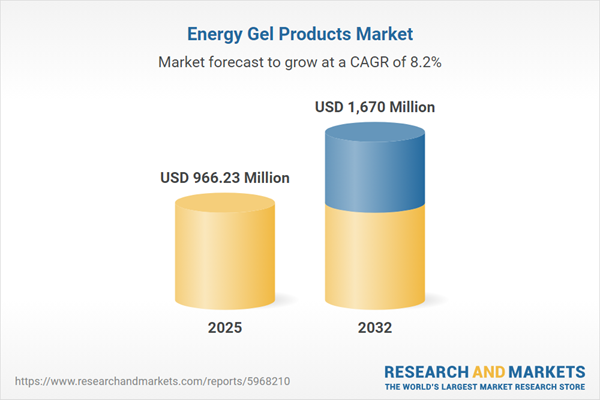Speak directly to the analyst to clarify any post sales queries you may have.
The energy gel products market is at a pivotal stage, shaped by evolving consumer nutrition priorities, technological developments in ingredients, and heightened supply chain and regulatory complexities. Senior business leaders require focused insights to adapt strategies and maximize opportunities within this dynamic segment.
Market Snapshot: Energy Gel Products Market
The global energy gel products market is on an upward trajectory, with sustained expansion projected from USD 895.40 million in 2024 to USD 966.23 million in 2025, and anticipated to reach USD 1.67 billion by 2032, at a compound annual growth rate (CAGR) of 8.17% over the forecast period.
Growth drivers include rising participation in endurance and fitness activities, increased consumer focus on holistic wellness, and formulation advances in nutrient delivery. Digital-first marketing, data-driven channel strategies, and rapid adoption of new sales platforms are enabling brands to meet evolving expectations swiftly. The market is also seeing a shift as digital tools and supply chain diversification become central to maintaining competitive advantage and responding to the needs of both established and emerging consumer segments.Scope & Segmentation
- Product Types: Caffeinated gels derived from both natural and synthetic sources; carbohydrate electrolyte gels enhanced with added sodium and key nutrients; carbohydrate-based gels leveraging ingredients such as fructose, maltodextrin, and similar sources; protein-enriched energy gels formulated for both endurance and post-exercise recovery, including plant and whey protein options.
- Applications: Solutions tailored for pre-exercise fueling, sustained intra-activity energy support, and efficient post-event recovery, targeting both serious athletes and everyday users seeking nutritional convenience.
- Distribution Channels: Specialty sports nutrition e-commerce sites, proprietary direct-to-consumer platforms, traditional retail outlets like supermarkets and hypermarkets, and integrated channel approaches designed to maximize brand exposure across markets.
- End User Segments: Amateur athletes aiming for performance gains, professional competitors with optimized regimen needs, and recreational users prioritizing functionality and ease in their supplementation routines.
- Regional Coverage: Global reach across the Americas, Europe, Middle East, and Africa, plus increased engagement in Asia-Pacific regions such as China, India, Japan, Australia, South Korea, Indonesia, and Thailand, each influenced by unique regulatory and cultural factors shaping market penetration.
- Industry Players Profiled: Clif Bar & Company, GU Energy Labs, Post Holdings, Science in Sport, Maurten AB, High5 Sports Nutrition, Torq Ltd., Hammer Nutrition, Huma Nutrition, and Enervit S.p.A., all considered for their adaptability and standards leadership in the sector.
Key Takeaways
- Growing interest in functional nutrition is expanding use of energy gel products beyond traditional athletes to wellness-focused consumers demanding portability and convenience.
- Progress in ingredient customization, including increased clean-label and plant-based offerings, boosts the ability of brands to address diverse taste preferences and differentiate portfolios.
- Greater transparency in formulation and sourcing builds consumer trust, supporting the market’s continued shift toward natural and plant-based alternatives.
- Digital commerce advances allow brands to analyze real-time user patterns, improve marketing personalization, and optimize inventory flow, driving better engagement across distribution channels.
- Companies prioritizing agile operational models and adaptive portfolios are better positioned to maintain resilience against ongoing regulatory changes and competitive challenges.
Tariff Impact: Navigating Regulatory Headwinds
Recent shifts in US tariffs have led manufacturers in the energy gel products market to reconsider their ingredient sourcing and production strategies. Increased focus on domestic ingredient procurement, as well as diversification of carbohydrate sources, is helping reduce supply chain risk. Automation, refined operational workflows, and robust contingency planning are proving essential to secure continuity of supply and maintain disciplined cost structures amid evolving regulatory and trade environments.
Methodology & Data Sources
This market analysis draws from in-depth primary interviews with key suppliers, comprehensive assessments of regulatory and financial trends, and end-user survey data. Insights are validated using a rigorous multi-stage modeling process, encompassing strict data cross-verification to ensure reliability and strategic value for industry stakeholders.
Why This Report Matters
- Enables organizations to benchmark performance and leverage deep segmentation to accelerate innovation, refine energy gel product offerings, and optimize channel strategies.
- Supports data-driven investment decisions in digital transformation, manufacturing upgrades, and supply chain fortification to ensure alignment with regulatory demands.
- Empowers senior B2B stakeholders to streamline product development, capitalize on differentiation, and enhance their competitive position in functional nutrition markets.
Conclusion
Strategic leadership in the energy gel products market depends on agile supply chain management, diversified product strategies, and robust digital operations. Timely adaptation to trends and regulatory shifts will allow organizations to harness emerging growth prospects across all regions.
Additional Product Information:
- Purchase of this report includes 1 year online access with quarterly updates.
- This report can be updated on request. Please contact our Customer Experience team using the Ask a Question widget on our website.
Table of Contents
3. Executive Summary
4. Market Overview
7. Cumulative Impact of Artificial Intelligence 2025
Companies Mentioned
The companies profiled in this Energy Gel Products market report include:- Clif Bar & Company
- GU Energy Labs, Inc.
- Post Holdings, Inc.
- Science in Sport Ltd.
- Maurten AB
- High5 Sports Nutrition Ltd.
- Torq Ltd.
- Hammer Nutrition, Inc.
- Huma Nutrition Inc.
- Enervit S.p.A.
Table Information
| Report Attribute | Details |
|---|---|
| No. of Pages | 182 |
| Published | November 2025 |
| Forecast Period | 2025 - 2032 |
| Estimated Market Value ( USD | $ 966.23 Million |
| Forecasted Market Value ( USD | $ 1670 Million |
| Compound Annual Growth Rate | 8.1% |
| Regions Covered | Global |
| No. of Companies Mentioned | 11 |









